The HTC 10 Review
by Joshua Ho on September 19, 2016 8:00 AM ESTSystem Performance Cont'd
Now that we've discussed how the HTC 10 performs in general purpose task we can turn our attention to tests that attempt to better test how a device performs in 3D gaming and other tasks that more strongly emphasize GPU and 3D API performance.

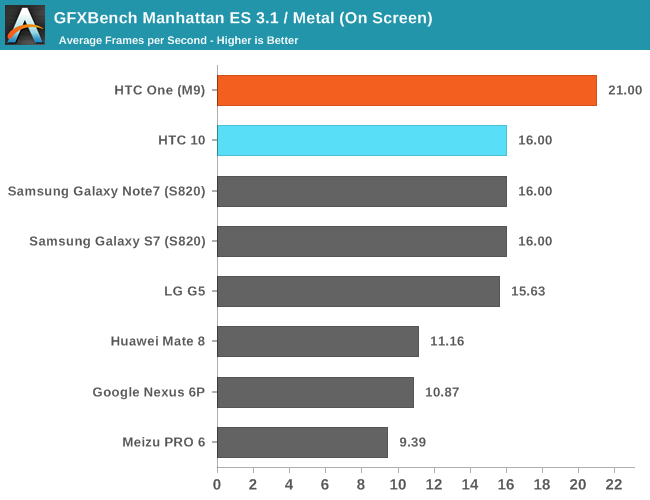


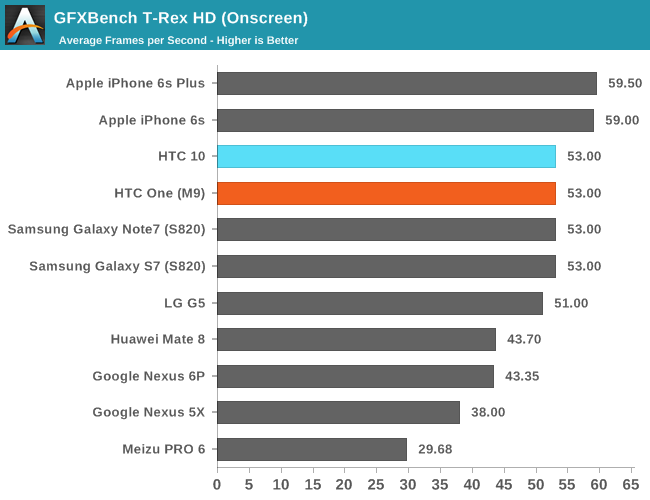
In the on-screen tests we can see the impact that the extra resolution has on GPU performance. Despite Adreno 530 providing a significant performance uplift the HTC 10 can actually give less GPU performance at native resolution depending upon the workload. Car Chase is fairly tesselation-intensive and uses ES 3.1, while ES 2 and ES 3 tests like Manhattan and T-Rex see parity between the two.
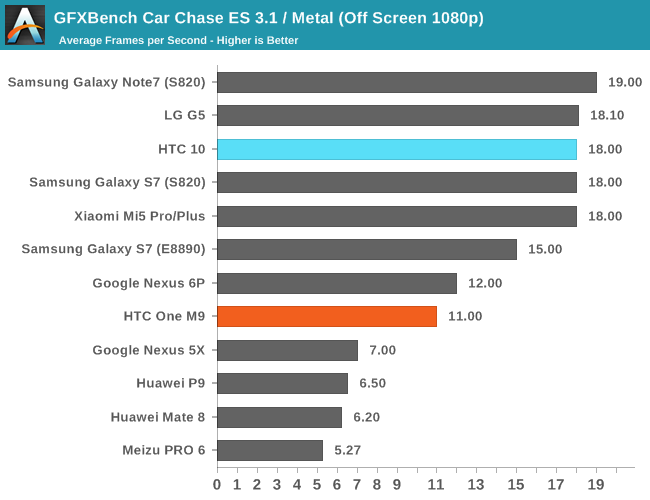
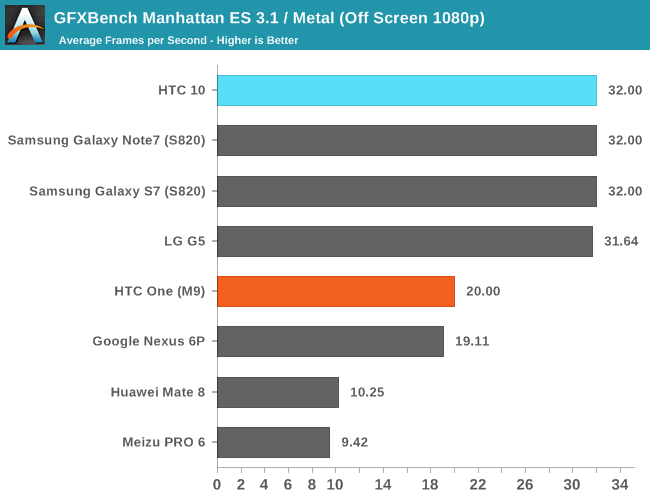
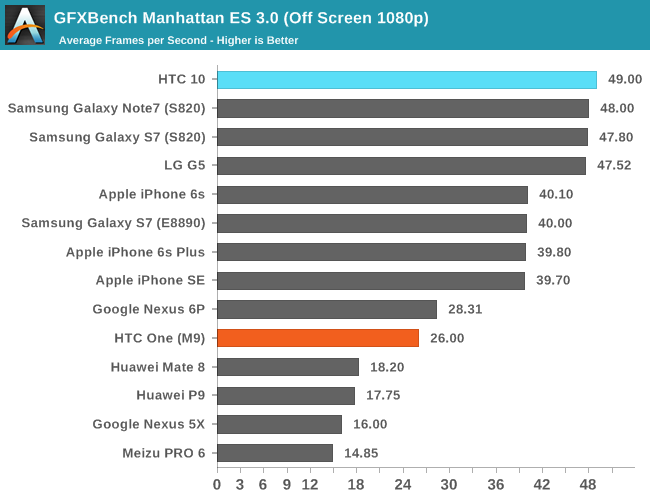
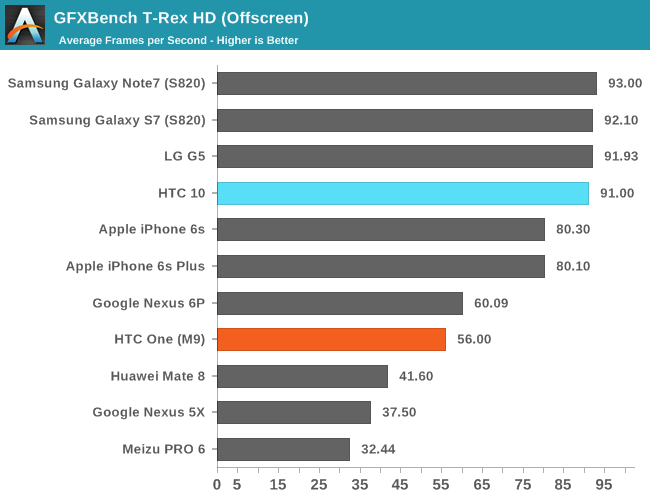
In 1080p off-screen rendering we see performance similar to applications that would render at non-native resolutions. Here the HTC 10 significantly outperforms the One M9 across the board and is in line with other Snapdragon 820 devices which is probably not a surprise.
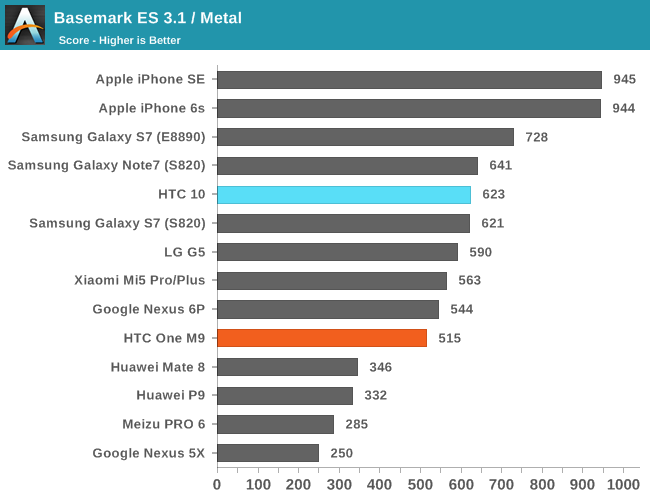
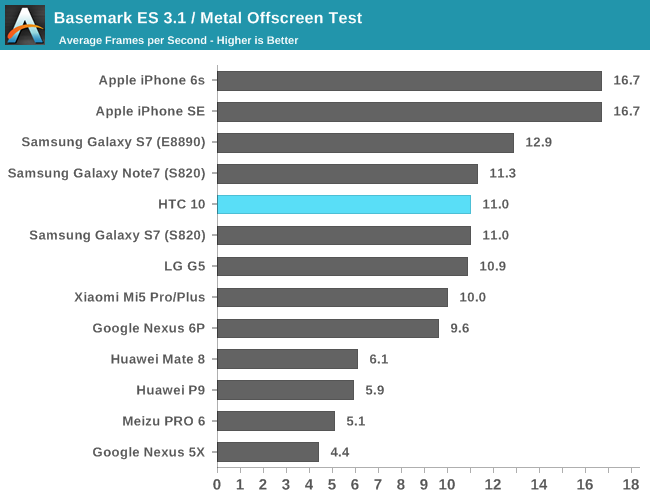
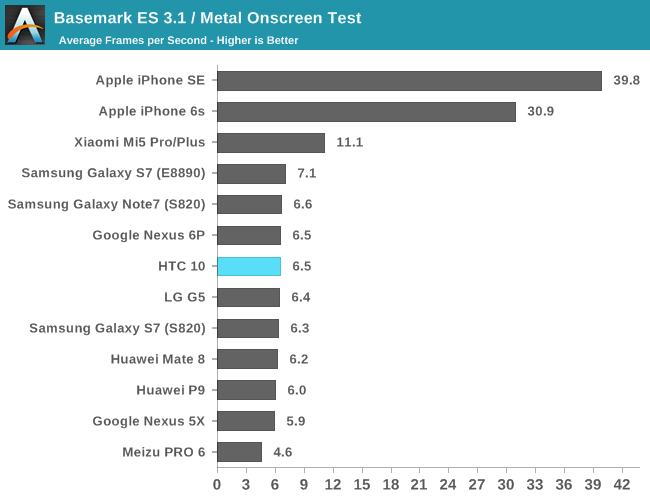
Performance here shows an uplift over the One M9, but this is primarily because the scores are based upon the off-screen results where resolution is equalized.
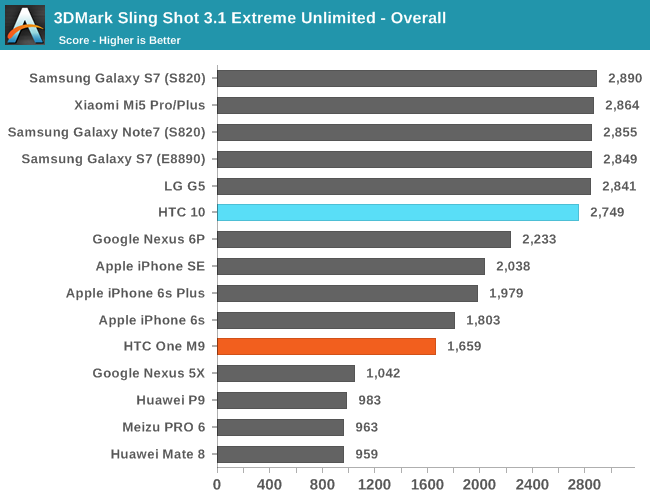
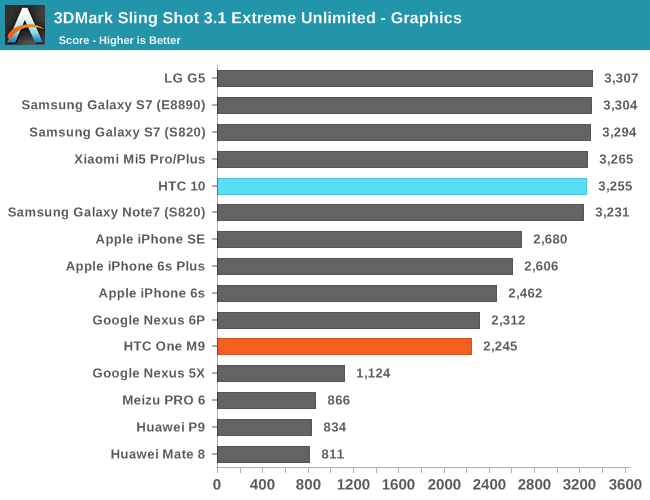
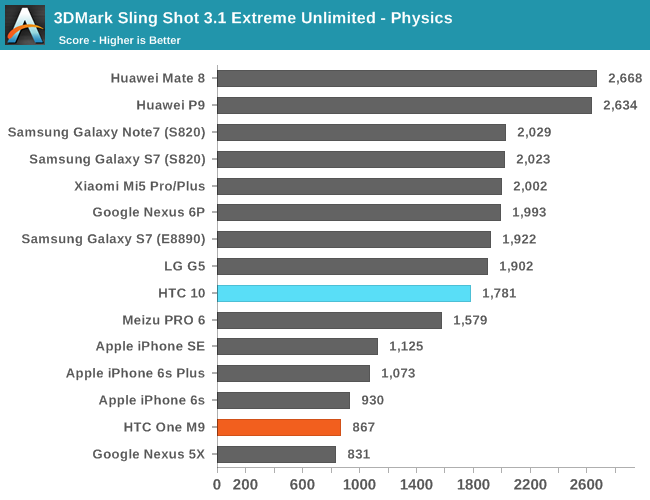
As 3DMark relies on off-screen rendering again we can see the benefit of Adreno 530 over Adreno 430 but this can only be achieved if you use the game optimization settings in the Boost+ application. Overall this isn't particularly notable outside of simple verification that nothing is seriously wrong with the software and hardware on the HTC 10.
NAND Performance
Storage performance, while decidedly difficult to test well in the mobile space and generally not all that well covered remains a fairly critical component of overall system performance. It’s definitely possible to hide memory performance issues with caching, but if you’ve ever taken a course on these things you can see that there is an upper bound to performance when it comes to caching. As a result, being able to improve performance at each step of the memory mountain is critical to having low latency and high throughput for data in the system. In order to test storage performance on mobile devices, we continue to rely on AndroBench 4 for Android devices. In order to properly test storage performance in a somewhat realistic manner we elect to test with only one I/O thread and a 100 MB test set with 4KB and 256KB block sizes for random and sequential rather than the strange settings of 8 threads and a 32MB sequential test which seems to be geared towards generating the largest numbers humanly possible rather than any meaningful throughput figure.
In the case of the HTC 10 it’s probably not a surprise at this point but it uses iNAND 7232 from SanDisk, seemingly as a single source supplier. This uses the SLC/TLC hybrid configuration seen in devices like the LG V10, iPhone 6, 6s, and 7 as well. The SLC storage is on the order of a few hundred megabytes, so sequential writes that exceed this size will see a drop-off in performance.
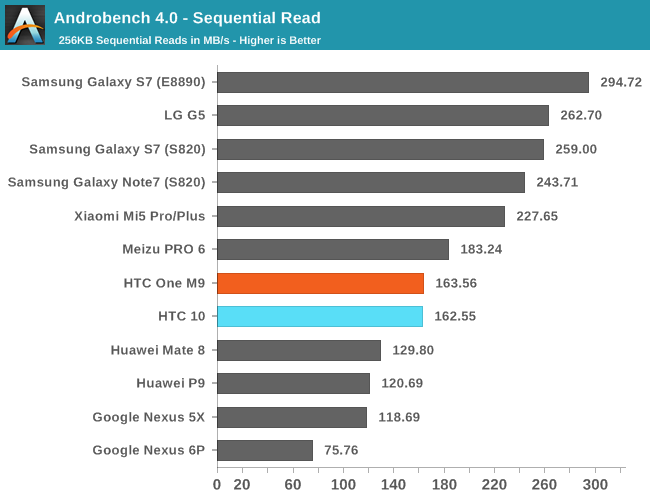
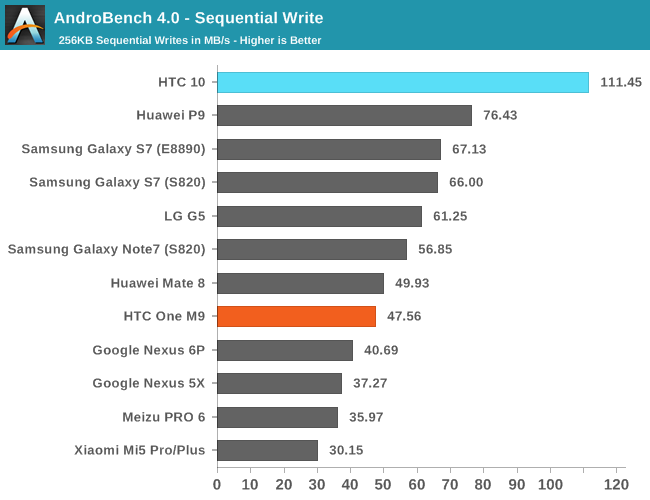
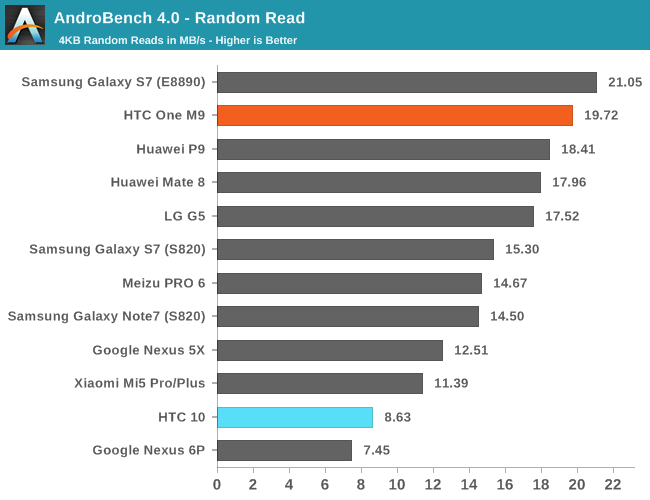
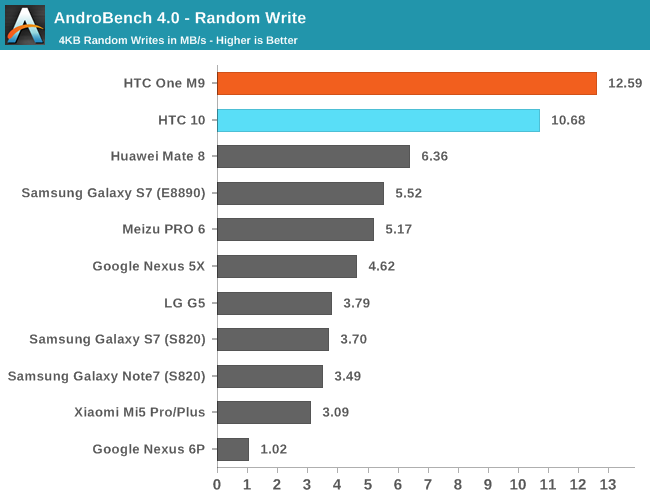
These results are probably not a surprise if you’ve been following our recent coverage but it’s still worth noting how the use of eMMC 5.1 is not guaranteed to be a huge impediment, although I would say this is probably the last generation where it’s acceptable to ship eMMC in a flagship device as the eMMC spec doesn’t seem to be progressing much further and UFS/NVMe solutions really seem to be the way forward as far as the industry is concerned. The HTC 10 is not really that far off from the UFS solutions we’ve seen in phones like the Galaxy S7 and from the Discomark results you can see that the eMMC 5.1 solution used here isn’t really causing a huge difference in performance, but I suspect anything that can actually take advantage of UFS’ more sophisticated controller will really start to highlight the weakness of eMMC and SDIO. At this point the industry already has UFS as a fairly widespread standard so HTC could take this route for a future flagship or NVMe storage depending upon their logistics. It's really important to emphasize here how UFS and NVMe are not necessarily better one way or another, as these things only matter when the storage or storage controller isn't the bottleneck.










183 Comments
View All Comments
TheMysteryMan11 - Monday, September 19, 2016 - link
Hate to be that person, but HTC 10 is dead. People have forgotten about that phone and moved on. Sales have tanked and nobody really gives a damn about this phone at this point.TheMysteryMan11 - Monday, September 19, 2016 - link
And yes, I know I am generalising here.close - Monday, September 19, 2016 - link
So what you mean is you don't care about this review. Cool. I think everyone got it from this first comment.Now it makes me wonder why you feel the need to defend your opinion about your personal preferences with so many comments... I'm starting to think it's because you're very insecure saying this and need to convince yourself you're right. Just be honest for a second: you actually think HTC is alive an well, that people still think about it and care about it but you are fighting this feeling and you're hoping that by repeating your "skeptic comment" you'll convince yourself.
This is the only explanation for a guy trying to convince others that he know better what they want.
And yes, I know I am generalizing here.
theduckofdeath - Monday, September 19, 2016 - link
I think it's more a complaint against this site. This review would have been relevant six months ago. Still, more relevant than this site is turning into, though. :DI really liked coming here before. I don't see much point with it any more. I mean, what the eff? The next gen HTC flagship is right around the corner, few stores have this model left in the booths and NOW Anandtech posts a review of it?
ACM.1899 - Monday, September 19, 2016 - link
i think it's not that late (compared to Apple lifecycle of 3 years); some places(countries) may have just received the phone or waited for it to become cheaper or...(assuming 5 months is a long time) : he could've analyzed the sharp panel as well as the its polarization or other issues that appear after a while (some in Xda-Forums) ; or testing or introducing a custom rom that of course is manageable through Xda.
nevertheless it was a great and in depth review, as always.
ArmedandDangerous - Thursday, September 22, 2016 - link
Here in Malaysia, the HTC10 JUST became available, and looking forward to getting one!berantle - Saturday, September 24, 2016 - link
HTC 10 was available in Malaysia since end July 2016. My unit was delivered in the 1st week of August. It's the official local unit and not a grey-market import.Prod1702 - Tuesday, September 20, 2016 - link
I 100% agree. I am not sure if having the review out months ago would of made the HTC 10 sell more but having it come out this late in the game doesn't help at all.RadiclDreamer - Tuesday, September 20, 2016 - link
Yeah, Im going to agree with MysteryMan11 here, this phone is so old even my grandma wouldnt be caught dead using it.eclectech - Wednesday, September 21, 2016 - link
I read this review on my HTC 10. Today, it's still a great phone. A great phone is a great phone, even when new phones come out.